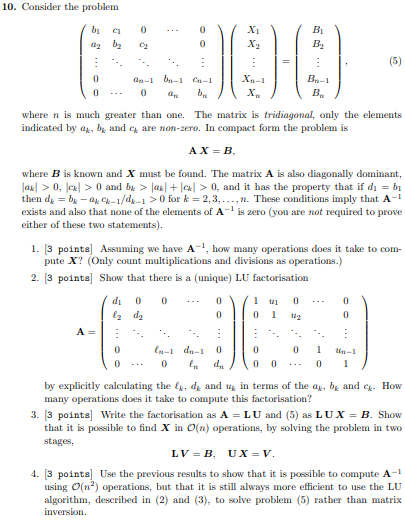
This question has previously been answered but answerscontradict each other and do not coincide with my (possiblyincorrect of course) solutions so I would like an answer that isdefinitely correct. Thanks!
10. Consider the problem bi 0 0 B: B2 0 X2 NG (5) 0 : An-1 -1 1-1 0 bre B-1 BE 0 X where n is much greater than one. The matrix is tridiagonal, only the elements indicated by a brand are non-zero. In compact form the problem is AX=B, where B is known and X must be found. The matrix A is also diagonally dominant, Tax > 0, le > 0 and bx >|4e| + || >0, and it has the property that if di = b then de be-9-1/dx-1 > for k= 2,3..., n. These conditions imply that A-1 exists and also that none of the elements of A- is zero (you are not required to prove either of these two statements). 1. [3 points) Assuming we have A-, how many operations does it take to com- pute X? (Only count multiplications and divisions as operations.) 2. [3 points) Show that there is a unique) LU factorisation 0 0 0 2d2 0 0 1 1 0 1 0 0 th A= E 0 0 1 0 0 0 0 U-1 1 0 4 0 0 by explicitly calculating the le, de and win terms of the ar, band C. How many operations does it take to compute this factorisation? 3. [3 points) Write the factorisation as A = LU and (5) as LUX = B. Show that it is possible to find X in O(n) operations, by solving the problem in two stages, LV =B, UX = V. 4. [3 points! Use the previous results to show that it is possible to compute A-1 using O(n) operations, but that it is still always more efficient to use the LU algorithm, described in (2) and (3), to solve problem (5) rather than matrix inversion.
没有找到相关结果